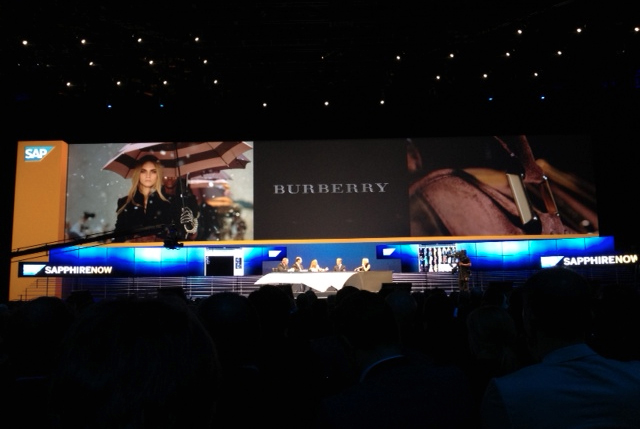SAP customers speak out at Sapphire

To close the evening keynote presentation on day one of SAP's Sapphire Now conference, co-CEO Bill McDermott welcomed three executives — Burberry CEO Angela Ahrendts, Ace Hardware CEO Ray Griffith and Coinstar/Redbox CEO Scott Di Valerio — to the stage, to talk about what's going on in their respective corporate trenches.

(Credit: Andrew Nusca/ZDNet)
Each had their own take on their application of technology to become more nimble or innovative companies. What follows is a summary of each executive's words.
Burberry's Ahrendts:
The fashion house started using SAP about six years ago, globally. It decided early on to set itself up as one global enterprise, eventually in 80 countries. "What we didn't want was a different platform in every country," Ahrendts said.
It just finished implementing China — it took six months and a thousand people. About 90 per cent of the enterprise resides on a single platform. "It is the backbone, the infrastructure of the business." Had it not been in place, Burberry couldn't execute on its digital innovations — including streaming runway shows and implementing click-to-buy capability and click-to-chat capability in eight languages.
"Our customer is going to have the ultimate in service," she said. Maybe you're a customer who bought three suits. Do you need a trench coat? Shirts? Ties? Stores will leverage purchase history to serve customers better.
Burberry used to be "a federation of businesses, very disconnected", she said. From design to distribution, planning to procurement to pricing — all elements are now touched by SAP's platform. Ahrendts said she likes that they're on a single platform, because it's easy to roll out new modules, such as the one for human resources. "Every year, you keep layering on," she said. "If you're a global business, the world is very complex ... keep it simple."
"How do you change your company to move as fast as society?" she asked the audience. "It's not just your customers; it's your workforce." Seventy per cent of Burberry's workforce is under the age of 30, she said. The company sees itself as "an innovation company".
"Society expects businesses to run differently," she said.
Ace Hardware's Griffith:
Ace turned on its SAP platform in 2011. The company positions itself as "the helpful place for most people", but it seeks to interface with the younger generation, and to also help retailers connect more readily with consumers in their community.
Technology was the answer, but it wasn't just for consumer and inventory data mining. Distribution for the 83-year-old company — its "backbone", Griffith said — is vital. Ace has been able to maintain a 97 per cent service level for its distribution centres, meaning that for every 100 products, it had 97 in the warehouse. But the company didn't know how well its supply chain was delivering products to them — were they coming in late? Were its suppliers maintaining a lower service level?
"We're going to take US$80 million out of a US$420 million inventory and reinvest those funds in consumer relationship," Griffith said. Now, the company has transparency into its inventory, both from a corporate point of view, and also from the perspective of individual retailers.
"How do you stay relevant to your end consumer?" Griffith asked. "How do you advance the ball up the field?"
Redbox's Di Valerio:
Di Valerio said that Redbox sees SAP as a tool to line up new businesses over next four to five years. By putting in CRM software and using HANA to query data from the 38 million customer email addresses it has, Coinstar and Redbox can better understand renting preference patterns, which improves suggested movies, and informs how it stocks its kiosks.
"We have to understand not only where our customers go and rent discs, but also [to] which kiosks they return them," he said.
The company had several legacy systems wired together that worked fine, but Redbox's tremendous growth required the quick scale-out capability of a uniform system. Coinstar has been an SAP shop for 10 years.
Now, it's looking at even more growth. One example: a coffee kiosk that brews the real deal. Another example: a gift card return machine that gives you money for those holiday cards you crack once and never look at again. Electronics also came up. And, of course, its EcoATM, which exchanges cash for old mobile phones, which it then resells in the developing world.
"It's about getting to know your consumer," Di Valerio said. "It's not so you blast them with emails and advertisements; it's about establishing a relationship with that consumer, so they feel like they're special and they advocate for the company because the company is bringing them something they like."
Via ZDNet US